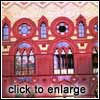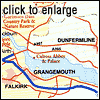|
Falkirk

Falkirk is another example of an older centre that whole-heartedly
gave itself over to industrialisation in the eighteenth and nineteenth centuries
and is now trying to find a way back to creating a more pleasant environment for
both residents and visitors. It has a busy, rather unattractive shopping area in
its centre with sections of defunct factories on the outskirts.
There is, however, a wealth of history going back
to Roman times when the Antonine Wall, the north-west extent of the Roman Empire,
was constructed in AD142 across Scotland's narrow waist to try and curb the war-minded
Picts. Having little effect, the Centurions finally abandoned the area and all lands
northward leaving the Picts to fight it out amongst themselves and later be pacified
by Christian influences.
At Rough Castle, 5 miles (8km) west of Falkirk, you
see some of the best remaining examples of the wall. The Roman road, which used to
supply the wall garrisons, can be seen nearby at Seabegs Wood.
At the Falkirk Museum, 15 Orchard Street, Falkirk's
archaeology and military history are explained in depth.
Just off the A803 west of Falkirk is Callendar House,
a 14th century keep that evolved into a beautiful and extensive country house. There
is the opportunity to enjoy dishes prepared to veritable recipes of the times in
a unique working Georgian kitchen where costumed interpreters recreate life in a
great house of the 1820's. There are also exhibitions, a museum shop and tea-shop
in the Stables.
 If you are driving along the A905 north of Falkirk, turning
off on the B9124 near Airth, you will be surprised to see one of the most exotic
pieces of architecture Scotland has to offer. A stone pineapple built in 1761 stands
45ft (14m) high at the side of the road. No one knows who built this folly or the
surrounding buildings, which were centrally-heated and used to grow real pineapples.
The 'Dunmore Pineapple' is run by the National Trust for Scotland and the adjoining
houses can be rented as self-catering holiday homes. If you are driving along the A905 north of Falkirk, turning
off on the B9124 near Airth, you will be surprised to see one of the most exotic
pieces of architecture Scotland has to offer. A stone pineapple built in 1761 stands
45ft (14m) high at the side of the road. No one knows who built this folly or the
surrounding buildings, which were centrally-heated and used to grow real pineapples.
The 'Dunmore Pineapple' is run by the National Trust for Scotland and the adjoining
houses can be rented as self-catering holiday homes.
An interesting debate arose a few years ago when an
American Professor reported that the stone lying at Meigle in the county of Angus
was Queen Guinevere's burial stone. He argued that the Arthurian legend took place
in Lowland Scotland and not the West Country of Cornwall as is more popularly believed,
although other areas such as Wales and Essex make a similar claim.
The village of Camelon on the western outskirts of
Falkirk seems too obvious a prop to add to the speculation, but it was noted that
this could have been the site of that legendary castle or at least the meeting place
of Arthur's Round Table. Today, the village offers the ubiquitous swimming complex
complete with wave machines and chutes with no sign of an Excaliber or round table.
Arriving in the town of Stirling itself, turn briefly
south-east from town on the old A9 to Bannockburn. Above the Bannockburn Heritage
Centre, the Saltire flag proudly flies, perhaps more so here than in other places.
Here, in 1314, lead by their unstoppable leader, Robert the Bruce, the Scots gave
their 'Auld Enemy', the English, a sound thrashing and, as they sing in Scotland's
alternative national anthem, Flower of Scotland, sent them homeward to think again.
The National Trust for Scotland puts on an admirable display describing the event,
the lead up to it and the historic aftermath.
The craggy crown of Stirling Castle and the massive
rock on which it stands can be appreciated from any angle of approach. As a symbol,
it represents a measuring rod of Scotland's history. Over the past 400 years there
have been seven major battles fought over these lands mainly in the cause of Scottish
independence. There is no doubt that it is the hugely advantageous position that
made Stirling Castle so important. The River Forth collects from numerous other waters
and meanders back and forth to form a wide alluvial plain. Before the eighteenth
century this was impassable marshland with the only decent north-south route crossing
through the town. Stirling was also the first point on the river that could be bridged
further, compounding its position as the 'key to Scotland'.
The city of Stirling is now effectively two towns
in one. There is the Castle and Old Town set on and around the outcrop of basaltic
rock, while the rest of this fairly typical twentieth century Scottish conurbation
stretches south and east.
The Old Town is still well preserved not only with
the magnificent castle but a splendid medieval church, the Holy Rude, as well as
merchants, dwellings, the Guild Hall, the Tolbooth and a broad market place. The
aristocratic Argyle's Lodging built in 1632 is one of Scotland's finest surviving
Renaissance mansions. All of this is easily explorable in a half-day.
There is a tourist information centre and a Stirling
Castle Visitor Centre, which can equip you with some insight into the castle's history.
It was the Stuart kings who embellished the castle and held court here in the fifteenth
and sixteenth centuries. In the Chapel Royal, Mary Queen of Scots was crowned at
the age of 9 months. Outside in Broad Street or throughout the Old Town, the local
tourist board has lead initiatives to bring the area's history alive by organising
various events.
The Stirling Old Town Jail is worth a visit, especially
to be scared half-witless by the actors who guide you through the epochs of this
ancient penitentiary. Compared to its predecessor, as we are informed, this must
have seemed like a luxury hotel. The jail's roof-top outlook, now accessed by a glass
elevator, provides excellent views of the castle and surrounding countryside.
There is a good transport link to see most of Stirling
on the Castle Shuttle or the open-top Heritage Bus Tour which both leave from the
railway station and town centre.
 A visit to the Wallace Monument means a steady climb but it
is well worth the effort. First you scale the 220ft (67m) high Abbey Craig hill on
the otherwise flat Carse of Forth, supposedly the position from which Wallace watched
his men defeat the English at the Battle of Stirling Bridge in 1297. The monument
sits like some kind of Victorian rocket ship about to take off. Above the door is
a bronze statue of William Wallace and inside is his double-handed claymore, which
gives you an idea of the stature of its owner. William Wallace was the father of
Scottish patriotism when the concept of a nation was almost non-existent amongst
the Scots, the Norse, the Angle-Saxon and Norman factions. Wallace came from an average
background, a young man in his twenties with the burning idea of one nation of Scotland
at a time when the country was cruelly subservient to its English overlords. A visit to the Wallace Monument means a steady climb but it
is well worth the effort. First you scale the 220ft (67m) high Abbey Craig hill on
the otherwise flat Carse of Forth, supposedly the position from which Wallace watched
his men defeat the English at the Battle of Stirling Bridge in 1297. The monument
sits like some kind of Victorian rocket ship about to take off. Above the door is
a bronze statue of William Wallace and inside is his double-handed claymore, which
gives you an idea of the stature of its owner. William Wallace was the father of
Scottish patriotism when the concept of a nation was almost non-existent amongst
the Scots, the Norse, the Angle-Saxon and Norman factions. Wallace came from an average
background, a young man in his twenties with the burning idea of one nation of Scotland
at a time when the country was cruelly subservient to its English overlords.
There are some 249 steps to reach the top of the monument.
The Hall of Scottish Heroes, two flights up, is a rather clinical collection of white
marble busts featuring such 'champions' as John Knox, David Livingstone and Adam
Smith. Further on is a parapet just below the cap of the monument from where you
can enjoy excellent views of Stirling Castle and the Forth Valley with the Trossachs
away in the northern distance. It is possible to drive to the monument if you are
unable to walk the half-mile up the hill, but most park in the facilities at the
bottom.
Bridge of Allan, north of Stirling, is an elegant
residential area established as a Victorian Spa town when the healing qualities of
its water were discovered. Now there is the University of Stirling on its western
end, one of Scotland's newer universities until colleges and polytechnics recently
acquired university status. The wooded grounds of the university are worth seeing
for their landscaping and views over to Wallace's Monument. There is a par 3 golf
course for the students while Bridge of Allan Gold Club (turn up the hill at the
bridge crossing the River Allan) is a fairly hilly 9 hole course with stupendous
panoramas of the Ochils and Forth Valley.
 Dunblane is a pleasant little residential town only a few
minutes drive from Stirling, build around and in close proximity to its cathedral,
a rare occurrence in Scotland where most cathedrals and communities are kept separate.
Once on the main route between Perth and Stirling, it is now by-passed, a quiet and
compact little town with narrow streets and walks along the Allan Water. St Blane
of Bute originally built Dunblane Cathedral in AD600. The present cathedral was built
in the thirteenth century although it fell foul of the Reformation and was partly
destroyed. After lying in ruin for nearly 300 years it was restored in 1892 to its
present exceptional condition. There are still parts of the old Celtic church found
in its red sandstone walls. The interior is well worth exploring for both its stained
glass and modern wood-carving. Dunblane is a pleasant little residential town only a few
minutes drive from Stirling, build around and in close proximity to its cathedral,
a rare occurrence in Scotland where most cathedrals and communities are kept separate.
Once on the main route between Perth and Stirling, it is now by-passed, a quiet and
compact little town with narrow streets and walks along the Allan Water. St Blane
of Bute originally built Dunblane Cathedral in AD600. The present cathedral was built
in the thirteenth century although it fell foul of the Reformation and was partly
destroyed. After lying in ruin for nearly 300 years it was restored in 1892 to its
present exceptional condition. There are still parts of the old Celtic church found
in its red sandstone walls. The interior is well worth exploring for both its stained
glass and modern wood-carving.
Three miles (5km) along the A820 is Doune, once the
pistol making capital of the country. It produced beautifully crafted weapons, which
are now museum pieces. Its coat of arms has pistols incorporated. Doune is a pretty
village on the banks of the River Teith and nestles in a vale with attractive wooded
hills to the north. In the seventeenth century it was also a thriving sheep and cattle
market with ramshackle stalls selling ale and broth to the locals and drovers.
Doune Castle, built in the fourteenth century, is
one of the best-preserved medieval fortifications in Scotland. It was established
by Robert Stewart, first Duke of Albany, who was one of the most powerful and unscrupulous
men in medieval Scottish history. Doune Motor Museum contains a collection of vintage
cars, some in working order and including such makes as Hispano Suiza, Bentley, Jaguar,
Rolls-Royce and Aston Martin. A number of events take place throughout the summer
including car and radio-controlled aeroplane rallies.
|




